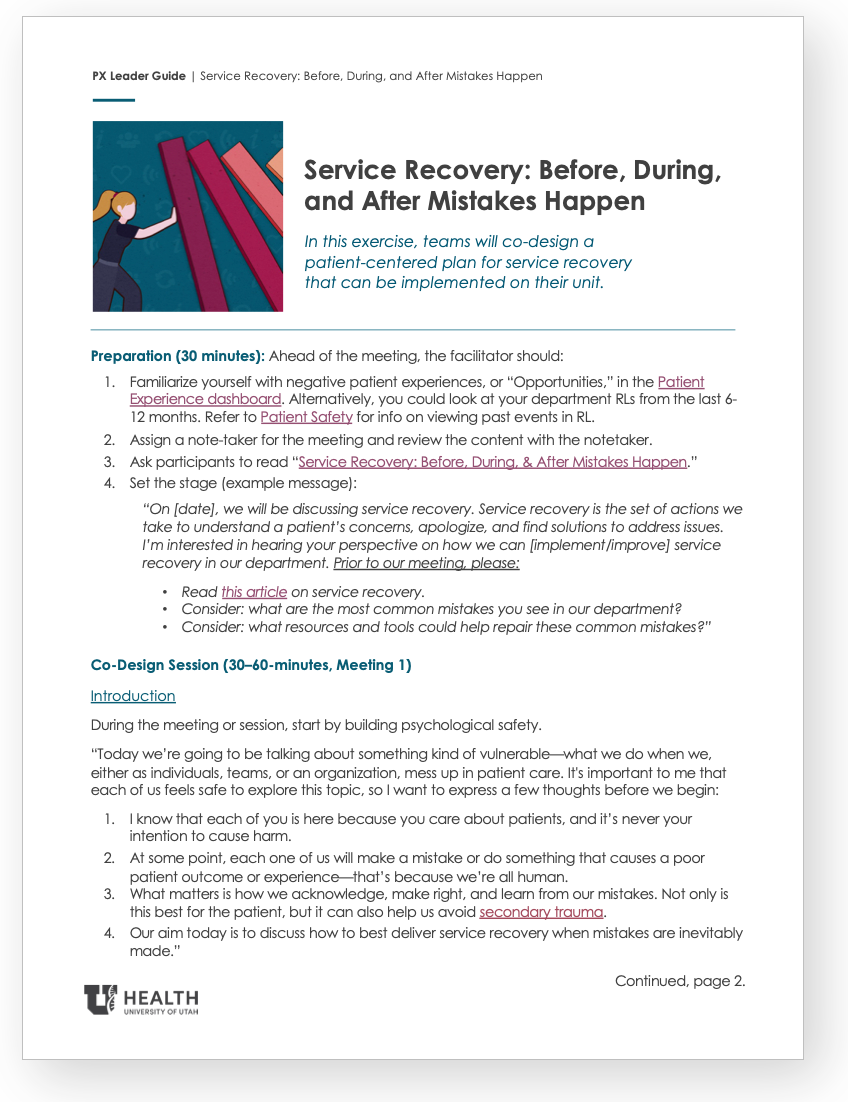PX Leader Guide

Download the Service Recovery Leader Guide for a team activity to co-design a patient-centered plan for service recovery.
e’ve all experienced mistakes as customers: a flight canceled, undercooked food at a restaurant, a package delivered to the wrong address.
As in any sector, mistakes happen in healthcare. Unlike other businesses, the stakes can be higher, emotions more fraught, and the costs significant—both figuratively and literally.
Service Recovery Can Help
When we do make a mistake, we can use a concept called “service recovery” to make things better. Service recovery refers to the actions we take to understand a patient’s concerns, apologize, and find solutions to address the issue. Depending on the situation, it can involve one or multiple steps.
Service recovery is used for a range of issues, from small to large. Individual caregivers, leaders, teams, or even multidisciplinary teams can coordinate service recovery, as the scope of the issue requires. For something serious, like disclosing a medical error, service recovery is part of a larger process that may involve more teams or departments.
Service recovery isn’t just for patients—although patients are the obvious recipients, we should be mindful of family members and friends who often play a critical role in the care of the patient. We should also design our programs with them in mind.
We can address service recovery at three levels: preventively, concurrently, or after the event. If managed appropriately, failures can become opportunities to increase trust in our system, not just with individuals and families, but for the community.
Pre-Recovery: Take a Preventive Approach
Whenever possible, we should try and anticipate barriers to care that a patient and their caregivers could experience. How we do this can vary by role:
System Administration:
- Identify system themes via patient comments and deploy system solutions (i.e., if patients complain about inpatient beds across multiple units, consider creating a system strategy for replacement.)
- Train and empower frontline caregivers to address problems when they occur. Employees can do a remarkable job of service recovery if given the resources and authority to address the problem. Provide recognition and publicize excellent recoveries!
Department and Clinic Leaders:
- Read patient survey comments weekly, with an eye for actionable improvements. For example, patients often tell us about typos in procedural instructions, inaccessible building elements, or broken fixtures. In these cases, you don't need to wait for a theme to appear or calculate statistical significance—one voice can be enough to prevent pain for others.
- Take a Gemba walk through your area. What “sticking points” do you see for patients?
- Develop “standard operating procedures” for common events that can't always be prevented in your area. For example, consider setting aside money in your budget for service recovery. Work with your senior leader and Compliance to use this money equitably and consistently with regulatory requirements.
Providers, Nurses, Schedulers, and other Caregivers:
- Raise concerns to your leadership about systemic concerns you see. What patterns have you seen? What prevents you from delivering the best outcome possible for your patient?
- Take advantage of skills days, in-services, and other training as opportunities to ask questions, apply your learning, and prevent the need for service recovery.
- Increase personal awareness by reviewing your personal survey feedback. What themes do you see? How do patients perceive you? Are there adjustments you can make to your personal style to connect more meaningfully to patients?
When a Mistake Is Made: Acknowledge and Make Amends
Inevitably, we will make mistakes. In most other facets of life, we are taught to respond to mistakes we make by apologizing and trying to make things better. In a health care setting, you may worry that you shouldn’t apologize for fear of malpractice. While we should avoid admitting or assigning fault prematurely or inappropriately, “apology laws” protect providers who express sympathy for errors or unexpected outcomes. It is our moral and professional responsibility to acknowledge when we do make a mistake and take steps to make it right.
Apologies in Context
Consider the patient's own context when thinking through an apology:
- Is the patient interested in an apology and its construction?
- Who is best positioned to make the apology? It may not always be the individual who made the mistake.
- Is the patient coming from a community that has suffered past medical injustices?
- What are the gender inequalities that might exist for this specific patient?
The Power of an Apology

HBP's Evelyn Nam shares how a pologizing is a complex and remarkable ability, one that requires deep reflection, self-awareness, empathy, and courage. (HBR 2023)
An authentic apology has the following components:
- Acknowledgement that a legitimate rule, moral norm, or social relationship was broken.
- Acceptance of responsibility for the violation.
- Expression of regret.
- Offer of reparation for the harm caused by the offense.
This is how this might sound in different situations:
A patient was left in the exam room for an extended time during a nurse visit.
“I’m so sorry for my long delay. After I roomed you, I went to care for another patient, who experienced an emergent event. In my rush to care for them, I lost track of time. I feel bad about the long wait this caused you. May I call an Uber for you so that you don’t have to wait for the bus to get home?”
A patient receives the wrong medication.
“There has been an unanticipated event in your care, and I am here to tell you everything I can. You did not receive the antibiotics we intended to give you last night. I am sorry this happened. We will watch you closely and provide any further care you need. What questions do you have?”
Someone else scheduled a patient incorrectly. A different person is checking them in.
“It looks like we accidentally scheduled you for a provider who doesn’t treat your condition. I’m very sorry for the mistake. I know you travelled for this appointment and were expecting to be seen. I checked with the care team, and there is a provider who can see you in about an hour. If you’re able to wait, may we buy lunch for you and your daughter?”
A patient recommends that a phlebotomist draw blood on their left arm. The phlebotomist insists on another location, which fails, and later successfully accesses the vein the patient suggested.
“I should have used the vein you suggested first. I’m sorry that I had to stick you twice. I realize that you’re the expert on your own body, and I’ll make a note in your chart about the arm that works best for blood draws.”
When Emotions Run High, use NURSE

Hospitalist and UACT co-director Claire Ciarkowski introduces NURSE: a simple framework we can follow to de-escalate with compassion.
While these examples address one-time events, patients sometimes experience systemic or repeated failures of the health care system. When this happens, we should respond with empathy, our best listening, and an aim to learn from their experiences. NURSE is an easy mnemonic that can help guide these conversations.
For complex or serious situations, rely on the following system resources to help you:
- Your area leadership
- Customer Service - 801-581-2668
- Risk Management
Post-Recovery: Learning from Service Recovery
When we can’t prevent the need for service recovery, we can learn from our mistakes for the benefit of future patients. We can lean into the discomfort of “messing up,” and approach problems with humility, curiosity, and compassion. When we have the courage to confront our mistakes, we can change healthcare for our patients, our loved ones, and ourselves.
Kathryn Young
The patient experience team shares resources to build coordination and teamwork centered on the needs of patients, caregivers, and families.
Our words can build, or erode, trust with others. Manager of Patient Experience Operations Ember Hunsaker offers insight into how our words may be helping, or harming, those around us and how to balance the scales.
Patients experience multiple handoffs, or transfers of care, during their visits, surgeries, hospitalizations, and scheduling. Every handoff is an opportunity to demonstrate trust and safety. Utah’s Patient Experience team shares universal best practices to apply.
